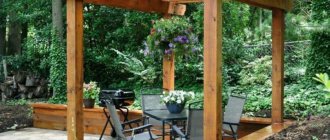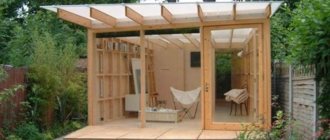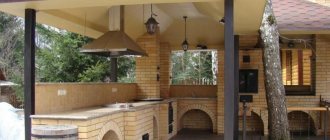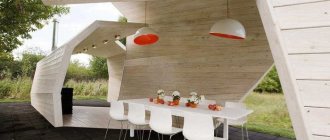A gazebo on a personal plot has become an integral part of landscape design. Sometimes it becomes a central element in the arrangement of the garden. If earlier it was used to shelter from the scorching sun and bad weather, now more stringent requirements are put forward for this building. It should be multifunctional and comfortable, because most often it is used for family vacations and friendly gatherings.
It’s hard to imagine a suburban area without a gazebo, where you can comfortably spend time with family or friends
Landscape design with a gazebo
Before you begin landscape design, you need to decide on the purpose, type and location of the gazebo.
A gazebo can be used in different ways; its functionality determines the appearance of the building and the interior design
Based on the purpose of use, it can be made in the form:
- open summer kitchen with grill or barbecue;
- covered terrace with hanging swing;
- recreation areas with Wi-Fi zone;
- open pergola;
- terraces with a permanent structure for a bathhouse or winter kitchen;
- terraces with a closed greenhouse and more.
Whatever the gazebo is, it must be covered. The roof and flooring are the main components of the structure. The walls can be blank, transparent, carved, decorative, or completely absent.
Some owners of summer cottages prefer to install a simple canopy that protects them from rain and sun
Others build a permanent structure and combine a gazebo with a full-fledged summer kitchen
Having decided what the gazebo will be used for, proceed to choosing a location. The design features, material of manufacture and design of the gazebo, as well as the availability of communications, interior decoration, furniture and decor depend on the purpose of the building.
We build it ourselves
Construction is conventionally divided into several stages:
- Selecting a location, clearing it of debris, roots, stumps and grass, leveling the surface.
- Digging a hole for the foundation, constructing formwork.
- Pouring the foundation.
- Installation of load-bearing vertical structures and securing joists.
- Construction of flooring.
- Roof installation.
- Painting and decoration.
Additionally, a wastewater outlet is constructed: a small pit is dug slightly to the side of the main structure, into which crushed stone mixed with sand is poured.
How to place a gazebo in the garden?
When they plan to treat guests to lunch in the open air, water, sewerage and electricity are supplied to the gazebo. Connecting communications requires the location of the building near the house. If they are not needed, then it can be in a secluded place away from street noise and prying eyes.
In the depths of the garden, a small gazebo with lattice or openwork decor looks romantic and airy
Small plots cannot boast of free space. A structure near the house or in the corner of the plot is appropriate here. In the first case, a wall-mounted type of construction is chosen, and in the second, a free-standing open or closed structure.
Even a small wooden gazebo will become a garden decoration if you complement it with carved elements
Popular ideas for the location of the gazebo:
- Far from everyone. Choose an isolated place in the depths of the garden, surrounded by trees and shrubs.
- Next to the summer kitchen. This option allows you to combine two buildings with a common terrace. You can spend time here both in the hot summer and in the harsh winter.
- At the side facade. A wall-mounted gazebo will be an alternative to an open veranda.
- Instead of a viewing platform. An uneven plot of land is not a reason to be upset. Even a landscape with a slope can be transformed by installing a gazebo on an elevated surface. It will replace the observation deck and allow you to admire the picturesque surroundings from above. But its main drawback is the airflow from all sides. A closed gazebo is installed on an elevated platform.
For a viewing gazebo, you need to choose a place from where you can see most of the suburban area
A gazebo equipped with a stove or barbecue should be located away from the house so that smoke does not spread inside during cooking.
The chosen place for arranging the gazebo must be dry. Wetlands and areas with high groundwater levels are not suitable for building gazebos. Also, the construction site should be in the shade. If there is no tree nearby, then it is necessary to plant green spaces.
Country style in the garden
It's a little more difficult to recreate. It is not enough to simply install a couple of ethnic elements on the site - a cart, a fence and arrange flower beds with a colorful variety of flowers.
The folk style is recreated according to the following rules:
- Decorative items are selected so that they match each other in color and texture. If wicker is chosen as the central element, then the furniture should also be wicker. Lattices, wicker decorations and carvings on the gazebo itself will complete the composition.
- Several flower beds with bright flowers for accents.
- The use of natural materials - stone, wood, wicker, clay, linen fabrics.
A gazebo in a folk style takes us back to childhood, reminds us of our roots, and strengthens our spirit.
It is important to observe the measure in the number of objects and decorative details. Don't use too many bright colors.
Tips for building a gazebo
Any construction begins with an idea. To choose the design style of the building, look at the photo of the gazebo in landscape design. Having chosen the design you like, decide on the size and shape of the future structure. Make a plan, drawing, estimate for materials and necessary tools.
The shape of the gazebo can be absolutely any: round, square, hexagonal or asymmetrical
The construction budget includes not only materials, furniture and accessories, but also takes into account the seasonality of the structure. A temporary structure made of wood is considered a popular type of gazebo. Wood is easy to process, making it possible to realize an exclusive design project. It is considered an environmentally friendly material that, with proper care, will last for many years. Wood must be periodically treated with antiseptics and fire retardants.
The huge advantage of wooden gazebos is that they are easier to make with your own hands
To extend the life of a wooden gazebo, the structure is often placed on brick or stone pillars
Metal structures will last for decades. Despite their durability, they are subject to corrosion and become very hot in the sun. Buildings made of brick and natural stone resemble permanent structures. They are used all year round. If you decide to install a fireplace, barbecue or barbecue, you need to make the chimney correctly.
Brick or stone gazebos are the most durable, designed for many years of use
A brick gazebo needs a foundation, but a collapsible structure can do without pouring a foundation. A summer gazebo without a foundation is appropriate on a flat, unflooded area. At the same time, the structure itself should be light. The collapsible gazebo can be moved from place to place.
The photo shows a portable gazebo made of waterproof fabric stretched over a metal frame
Its construction does not take much time and money. Despite its compactness and low cost, this type of design will last no more than 10 years. Wet soil negatively affects the bottom of a wooden gazebo. The collapsible structure must be treated with an antiseptic solution to improve resistance to environmental influences and “repel” insects.
The photo shows a simple beach gazebo that can be installed on any flat area
The photo shows a small gazebo made of boards - unusual in shape and simple in execution
To increase the strength of the structure, a base is built from brick or stone, crushed stone is poured under the bottom of the structure, and car tires with sand or concrete slabs are placed.
Types of gazebos without foundation:
- stationary or collapsible metal structure;
- canopy with awning;
- pergola;
- pergola.
The most interesting type is the “living” gazebo. It consists of several arches, near which climbing plants are planted. This type of summer construction is not for everyone. It fits into landscape design like no other, but it will require a lot of effort and time to create. In addition, a gazebo made of climbing plants is a seasonal structure. The gazebo will not save you from rain and wind, but will be an excellent place to relax on a fine day.
Maiden grapes are perfect for constructing a “living” gazebo; within a few years after planting, they will literally fill the frame allocated to it.
An even more interesting solution is to plant willow twigs and grow a gazebo of the desired shape from them
Construction of a gazebo using a description of step-by-step actions:
- Develop a drawing.
- Purchase supplies.
- Clear and mark the land.
- Mount the structure frame.
- Install the roof.
- Decorate the structure.
When installing a wooden gazebo, the procedure includes the following:
- The wood is well dried and coated with an antiseptic in several layers.
- After marking the area around the perimeter of the future building, they place pegs and pull the fishing line.
- Then they make the lower harness from 4 beams. To do this, grooves are made in the timber so that together they are in the same plane.
- Load-bearing supports are installed at the corners of the structure. Intermediate columns are placed between the pillars, to which decorative grilles are attached.
- The mauerlat is attached to the supports, then the rafters are mounted and proceed to the roof and flooring.
Many people use alternative foundations made from car tires, pipes, concrete blocks and brick posts to reduce construction costs.
Vegetation around the garden building
Often, garden gazebos and verandas are decorated with hanging plants. They have long, flexible, curly shoots that tend upward or spread along the ground.
Flowers are placed at different levels both inside the building and outside in pots or cache-pots, as well as simply in the garden bed. Near the entrance there are low-growing plants, and in the background, on the contrary, there are vines and tall shrubs.
If climbing plants are properly cared for, they will grow over time and cover the building with a continuous carpet.
The basic rules for landscaping a gazebo are as follows:
- You shouldn't use too many different types of plants, one or two is enough. At the same time, they should fit well with each other.
- In the flower beds near the gazebo, it is best to plant plants that bloom at different times, then the building will always be surrounded by flowers.
- For climbing plants, trellises should be installed to allow them to climb and grow upward.
The most popular climbing plants are wild grapes and ivy, and the most popular flowering plants are roses and clematis.
A gazebo covered with ivy or flowers does not need additional decor; it already looks presentable.
Climbing plants not only give beauty and coolness, but also hide from prying eyes.
Main types of gazebos
Without knowing what types of gazebos there are and what their advantages are, you will not make a choice. Buildings are divided into two broad categories: open and closed.
There is a third type of gazebo - a semi-closed building with one blank wall
Gazebos are also distinguished according to the following criteria:
- type of construction – stationary or collapsible;
- seasonality of use – summer or year-round;
- shape – round, rectangular, square;
- material of manufacture - wood, brick or forged.
Each type has its own advantages and disadvantages.
Open type
The classic version of a summer building is a roof on supports and piping made of various materials. Outwardly, it resembles a pavilion with three semi-closed walls and one open.
The photo shows a classic octagonal open gazebo
An open gazebo is a budget option for a building that protects from sun and rain. Its main drawback is its use in the warm season. The structure does not protect against cold, winds, dust and insects, therefore it is not intended for use in winter.
Closed type
A closed gazebo is a more reliable structure that can be heated. The structure, equipped with communications, resembles a miniature residential building.
Wood, brick or stone are used to build a closed gazebo
Advantages of a closed gazebo:
- weather protection;
- wide choice of furnishings and decor;
- Possibility to use the premises as a guest house.
Construction of a closed gazebo will require more investment and time, pouring the foundation and a spacious place for installation.
The photo shows a closed wooden gazebo with windows covered with mosquito nets
Wrought iron gazebo
A forged gazebo comes in the form of a belvedere, pergola or gazebo. It is a durable and reliable design. A forged gazebo is a laconic option among its analogues.
Round forged gazebo with polycarbonate roof
Rectangular gazebo with metal roofing
If wooden and brick buildings do not surprise anyone, then a forged structure can become unique in its kind. Strict lines, ornate shapes and fancy patterns between its supports will help create an exclusive gazebo.
Materials for the floor and roof of the gazebo
The gazebo floor can be made of wooden planks or garden parquet. Wooden blocks or rounds buried in the ground look original. You can use a material such as concrete slabs or natural stone for the gazebo floor (depending on the finish of the garden paths or cottage). The floor of the garden gazebo can also be tiled.
A gazebo with a rigid floor does not need to be additionally connected to the ground. It is enough to install it on a gravel bed or on paving slabs laid on stone or crushed stone. Under wooden elements in direct contact with the ground, waterproofing is made of roofing felt or roofing felt.
The roof is the crown of creation in the gazebo. Its shape can be very different: convex or flat, square, round or rectangular, two- or three-tiered, etc. The material of the roofing is also important. Soft self-adhesive bitumen shingles are especially popular. It does not melt in the heat, does not warp or harden in the cold, lasts a long time, and is easy to install. Metal tiles should not be used as a material for the roof of a gazebo - although they are very durable, they are heavier and “louder”: raindrops knock loudly on them.
Some homeowners prefer natural materials and cover gazebos with wood or reeds. This method is very expensive and is suitable for those owners who rely on the originality of the building. Often, in order to create a unified style ensemble, the gazebo is covered with the same material as the main residential building on the site.
The simplest and cheapest solution is a PVC awning. And if you don’t need protection from rain, you can limit yourself to an openwork roof made of slats or metal rods. Climbing plants that will eventually cover the exposed roof structure will provide excellent sun protection.
Arrangement of the interior of the gazebo depends on your ingenuity. It can include permanent benches and a table, or elegant garden furniture, flower pots or hanging containers.
This selection of photos shows beautiful hand-made gazebos in the garden:
How to arrange a summerhouse from the inside?
In the interior decoration of closed gazebos, plastic panels, plywood, lining, tiles, and stone are used. Upon completion of the finishing work, they begin to create the interior. Benches, a table, and garden furniture are installed inside. Several points are used for lighting: a chandelier in the center, and lamps around the perimeter. If desired, window openings can be covered with curtains.
For a comfortable stay, you can install comfortable upholstered furniture inside the gazebo.
Stylistic decision
The design options for the gazebo should highlight the design of the entire site. As photos of gazebo design show, these cozy buildings can become an element that attracts attention, or a structure hidden from prying eyes.
In any case, the style of the gazebo should match the created or planned landscape.
Classic style
The design of a gazebo in a private house in a classic style is distinguished by expensive decoration and contents. A soft, woody palette of colors will bring coziness and tranquility to the room.
The materials for it will be wood or brick. Carvings are used for decoration, and a solid table and chairs are placed symmetrically inside, emphasizing the family’s wealth and confidence in the future. Decorative elements should also be luxurious.
Forest style
The design of a summerhouse in a forest style involves the use of wood. It is used to create floors, walls and roofs.
Some of the vertical partitions can be created using vines entwining the supports. Instead of the usual furniture, you can install stumps instead of seats, and make a table from a solid board.
Country style
Do-it-yourself gazebo design in country style will help you create a bright and attractive structure.
The style will be created by:
- natural materials (preference is given to wood);
- natural colors;
- self-made or aged furniture;
- bright decorative elements (embroidered napkins, elegant tablecloths and curtains, homespun carpets, pottery).
Provence
Style is different:
- calmer, as if faded colors;
- using vintage furniture predominantly in white shades;
- fine dishes;
- elegant decor, of which there should be a lot.
Vases with bouquets of garden flowers, baskets of fruits and vegetables, and antique candlesticks will look natural here.
Chalet style
The landscape design of a gazebo in this alpine style will be the opposite of the lightness and sophistication of country.
The structure is built from stone and wood and is massive and durable. The same properties are manifested in the internal filling.
In such a gazebo there is solid and heavy furniture that can overcome all weather troubles. A stone fireplace will be an elegant addition.
Chinese style
Chinese-style gazebos perfectly imitate charming tea houses. Ideally, they are made from bamboo or straw, but in most Russian gardens these impractical structures will fall apart after a season. Therefore, wood is used to build beautiful pagodas.
The entrance to such a gazebo is located on the east or west side, the south side is a blank wall.
The gazebo is located on a small hill and surrounded by fruit trees. If you place a small pond or waterfall nearby, the Chinese-style gazebo will look even more harmonious.
Low benches or chairs and a light table are installed inside. Numerous pillows take up free space.
Russian style
A gazebo in the Russian style can be an imitation of a rich merchant mansion or a simple rural hut.
- In the first case, wood carving is used, the roof or supporting pillars are decorated with onions.
- The second option is distinguished by its simplicity of design: a classic quadrangular gazebo is created from logs and does not have a lot of decorations.
In any option, wood is used, a wooden table and chairs (benches) are installed inside. A samovar on a table, embroidered textile elements, or lilac or elderberry bushes near a building will perfectly restore the antique style.
Scandinavian style
Buildings in the style of cold Scandinavia are closed structures with windows and careful insulation. Instead of solid walls, you can use panoramic glass.
Very often it is presented in a round shape, less often a rectangular configuration is used. Cool white tones and light natural wood are used for decoration and decoration. Brighter blankets and decorative pillows will add a little variety.
An excellent addition to a room designed to escape the cold would be a fireplace or hearth located in the center of the gazebo.
Minimalism
The main features of a gazebo in the minimalist style will be:
- laconism and simplicity of forms;
- calm colors;
- openness of space.
A minimalist gazebo is characterized by calm tones, the use of both natural and artificial materials, a minimum number of objects and an almost complete absence of decorative items.
Different design options for gazebos will help you create a surprisingly comfortable room in which it will be pleasant to sit alone, with family members or large groups.
What plants to use near the gazebo?
There should be a paved path leading to the gazebo, along which street lights are installed and flowers are planted. Climbing flowers are planted near the building itself or a hanging flower pot is used for a hanging flower bed. Light shade is provided by cultivated grape varieties, aroma is provided by mock orange, sweet peas, petunias, and carnations. On the way to the gazebo, you can install small architectural forms and plant perennial flowering shrubs.
A wooden gazebo decorated with climbing roses looks beautiful
To protect the interior space from the sun, you can plant climbing plants along the walls of the gazebo.
The best place for a gazebo
A quiet, shady place, maximally protected from bad weather, is suitable for a gazebo. It is important that it offers a beautiful view of the surrounding nature. Often buildings are erected on a hill to protect them from moisture, near flower beds and ponds.
The pond located near the gazebo gives coolness and peace.
A great idea would be to surround the building with a monogarden or rose garden, hedges, coniferous or climbing plants. This will help isolate people relaxing in the gazebo from noise and road dust, as well as protect them from the sun.
The place for the gazebo is selected in accordance with the location of the house. Both buildings should be at the same level, or the gazebo should be at the level of the first floor of the house.
A large number of green spaces and neat paths with carefully trimmed bushes will give the site a well-groomed appearance.
Unusual ideas for garden gazebos - photos
Look at the landscape design ideas with a gazebo in the photo and choose the appropriate option. Even on a small garden plot, you can arrange a gazebo or order the construction of a building according to a standard design. The gazebo will become a favorite vacation spot for the whole family.
The most famous and low-maintenance plants for a gazebo
Most often, perennial climbing plants are used in the design for the gazebo. They have many advantages:
- Resistance to fungal diseases and pests;
- A high degree of frost resistance is an indispensable feature for use in almost all cold regions;
- Possibility of living in one place for a long period without transplantation and loss of decorative aesthetic properties.
Let's look at a few examples in detail:
- Maiden (Amur) grapes. In the summer it produces abundant green foliage, which turns into a fiery mass of yellow, orange and red in the fall. The grapes fully develop in 2-3 years. Its leaves densely cover the roof and wall of the building, creating shade and protection from drafts;
- Echinocystis. More popularly known as "mad cucumber" and considered by some gardeners to be a simple weed. Its reproduction occurs by “shooting” seeds at a distance. This type can quickly and easily wrap around any surface. When flowering, these climbing plants emit a pleasant scent that actively attracts a large number of pollinating insects. It grows very quickly, creating a thick green mass. Thanks to its absolute unpretentiousness, it can feel good even in Siberian regions;
- Ivy. Suitable for decorating almost any surface to which it is attached with suction cups located on the leaves. For the winter, shelter or transplantation into a container that must be kept indoors is required.
High-tech style
Gazebos made in high-tech style can have completely different shapes. They look the most modern. Dimensions - at the request of the customer, a prerequisite is the presence of right angles. In combination with a swimming pool, fountains or street lamps, high-tech gazebos can become a real “highlight” of your site. The main materials used in the work are glass, metal and wood.
The building project can be developed individually, taking into account the wishes of the customer. The cost depends on the level of difficulty.
If you decide to order a gazebo, you should consider the style of the garden plot and the purpose of using the structure. If you prefer to spend time in solitude with a good book or in a close family circle, an open gazebo will suffice. If the structure is intended to be used constantly, even in winter, it should be closed.
What wood is suitable for beautiful wooden gazebos?
In our latitudes, it is best to choose coniferous wood: pine, larch, fir and cedar. These rocks are resistant to moisture and decay, strong and durable, so they can act as both a material for supporting elements and cladding.
Design: Paul Hendershot Design
Design: Paul Hendershot Design
Design: Alexey Razorenov
Design: Alexey Razorenov
Passionflower - seasonal perennial for the gazebo
If you don't visit your gazebo often, then seasonal perennial plants are an excellent solution for you. They do not require special care, and they successfully decorate the gazebo. Perennials do not grow as rapidly as annuals. It will take about two years to obtain a dense, thick, “living” hedge.
Passionflower is the best option for a perennial “green friend” and is highly valued by gardeners for its excellent decorative properties of flowers and leaves. She needs nutritious soil and high-quality lighting. In the winter season, passionflower is moved indoors, as it does not tolerate cold and frost.











